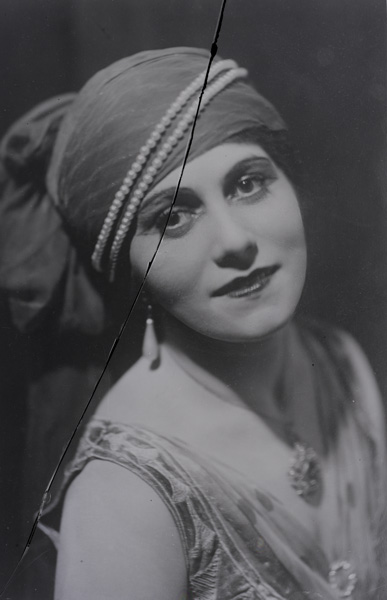Olga Stepanova Khokhlova was born in the city of Nezhin in the Russian Empire on 17 June 1891,3 the daughter of Lydia Vinchenko and Stepan Vasilevich Khokhlov, a colonel in the imperial army. She grew up in Saint Petersburg with her three brothers and her younger sister.4 Of the two elder sons, one chose a military career, while the other pursued the study of medicine. The girls turned to the arts: Nina hoped to sing and Olga chose dance.5 In 1910, Stepan Vasilevich was transferred to the Kars region. Rather than accompany the family, Olga, who had just completed her studies at the French lycée, decided to remain in Saint Petersburg to enter the dance school of Yevgenia Sokolova.6 Through her connections with the Konetskie sisters, she was auditioned the next year by Serge Diaghilev and engaged by the Ballets Russes.7
As an extension of the major exhibitions and stage productions he had organized in Russia and France,8 Diaghilev founded the Ballets Russes, which appeared for the first time at the Théâtre du Châtelet in Paris in May 1909. With Michel Fokine, the troupe’s choreographer until 1912, Diaghilev sought constantly to reinvent the form of his productions, bringing theater, music, and painting together in a dramatic unity closely akin to the Romantic principle of Gesamtkunstwerk. While the first season was a major success, the productions staged the following year at the Théâtre National de l’Opéra, particularly the production of Scheherazade with Ida Rubinstein in the title role, were a triumph, and their colorist aesthetic set off a vogue in fashion and the decorative arts. The energy of Fokine’s choreography, heightened to the extreme by the set designs of Alexandre Benois and Leon Bakst and the talent of the dancers---among them Anna Pavlova, Tamara Karsavina, and Vaslav Nijinsky---aroused such enthusiasm that Diaghilev decided to create a permanent ballet troupe that would perform throughout Europe. As a result, the impresario began recruiting dancers from the imperial theaters: the Mariinsky in Saint Petersburg and the Bolshoi in Moscow. He also engaged amateurs, though these dancers, too, had to attain perfect command of the arts of ballet and pantomime as taught by the great Italian ballet master Enrico Cecchetti, and meet Fokine’s choreographic demands and, later on, those of Nijinsky and Léonide Massine.9 Fokine was steeped in Russian folklore, while Nijinsky, drawn to Classical antiquity, turned the schoolroom canons of dance upside down, offering male dancers authentic dramatic roles for the first time instead of employing them merely to lift the ballerinas or in walk-on parts. Massine drew his inspiration from the study of popular dances, the circus, jazz, and the cinema. At age twenty, Olga Khokhlova, like her fellow pupil Ludmila Guliuk, a niece of Sokolova, was one of the youngest, least experienced ballerinas. Recruited with four professional dancers from the Mariinsky to join the company at Monte-Carlo in March 1911, both young women had to rapidly memorize their first choreographies.10 Tamara Karsavina recalls that Olga “had started as a quite gifted amateur, but under the direction of the master [Cecchetti] she had revealed authentic qualities.”11
3 Now Nizhyn, in Ukraine. The city lies about 150 kilometers northeast of Kiev.
4 The passport issued to Olga Khokhlova, dated Petrograd, 23 November 1915, identifies the dancer as “La fille du colonel” (the colonel’s daughter) (FABA Archives).
5 Nikolai was stationed as an officer in Belgrade, and Vladimir studied medicine at Yaroslavl. The youngest son, Evgeny, died prematurely in October 1917. Nina enrolled in the program of the Tiflis Conservatory. A photograph taken in the apartment on the rue la Boétie (reproduced in Le Miroir noir: Picasso, sources photographiques, 1900-1928, exh. cat. (A. Baldassari ed.), Paris: Réunion des musées nationaux, 1997, pp. 203—4), and a drawing done by Picasso at Fontainebleau (Z.IV.298) show Olga playing the piano. She seems also to have had a piano-teacher aunt named Sasha who had studied with Anton Rubinstein. Information on the Khokhlov family is based on the Russian correspondence preserved by Olga Picasso (FABA Archives), currently undergoing translation by Olga Gribenchikova.
6 Bronislava Nijinska, Early Memoirs (trans. and ed. by Irina Nijinska and Jean Rawlinson, with an introduction and special consultation by Anna Kisselgoff), Durham, NC, and London, Duke University Press, 1992, p. 333.
7 Olga would have been initiated into the dance by Matilda Konetskaya, the older sister of Olga’s school friend Lubov. Originally a dancer in the Mariinsky Ballet, Matilda had joined the Ballets Russes and managed to have Olga and Lubov auditioned. See Natalya Semenova, “A Tale of Brief Love and Eternal Hatred,” cited in John Richardson, A Life of Picasso. Vol. III: The Triumphant Years, 1917-1932, with the collaboration of Marilyn McCully, New York, Knopf, 2007, pp. 5 and 511 n. 9. We do not know which of the two sisters appeared under the name “Konietska” in the Ballets Russes programs from 1911 to 1914.
8 Examples are the Mir Isskustva (World of Art) publications, the exhibition of Russian art in the Salon d’Automne of 1906, and the production of Modest Mussorgsky’s opera Boris Godunov, presented by Diaghilev in 1908 and starring the Russian bass Feodor Chaliapin.
9 Given the chronological limits of this study, we shall not discuss the innovative choreographic work of Bronislava Nijinska or George Balanchine after 1917.
10 The professionals were Ludmila Schollar, Lubov and Nadejda Baranovitch, and Nijinska. See Nijinska, Early Memoirs, op. cit., pp. 332--33.
11 Tamar Karsavina, Ballets Russes. Les souvenirs de Tamar Karsavina, Paris, Plon, 1931, p. 267: “avait débuté comme amateur assez bien doué, mais sous la direction du maître [Cecchetti], elle avait révélé de véritables qualités.”





 Summary
Summary